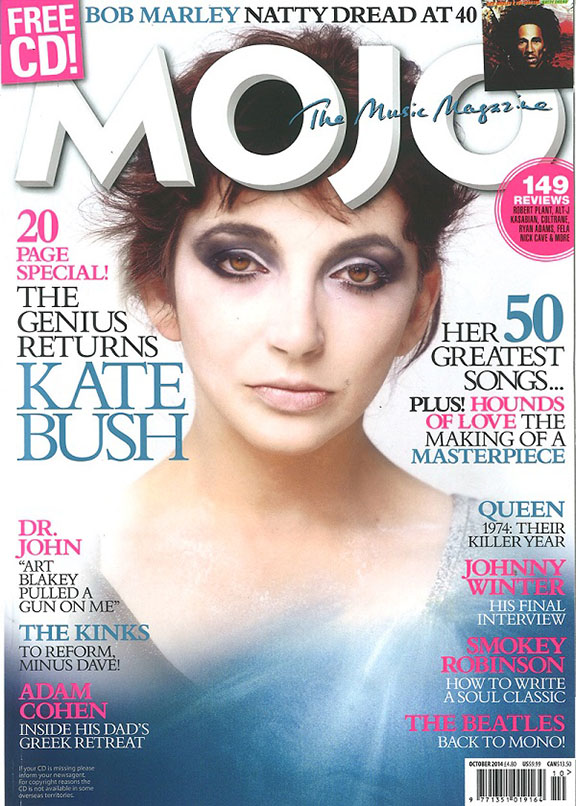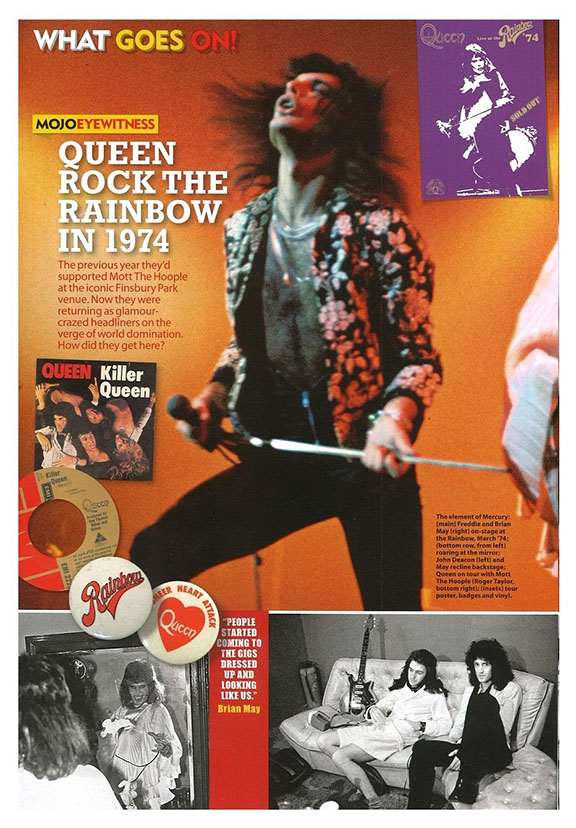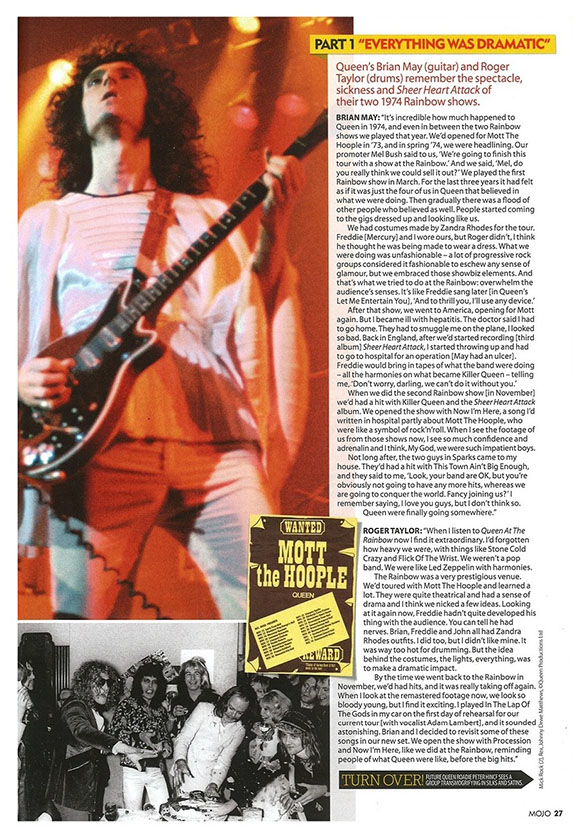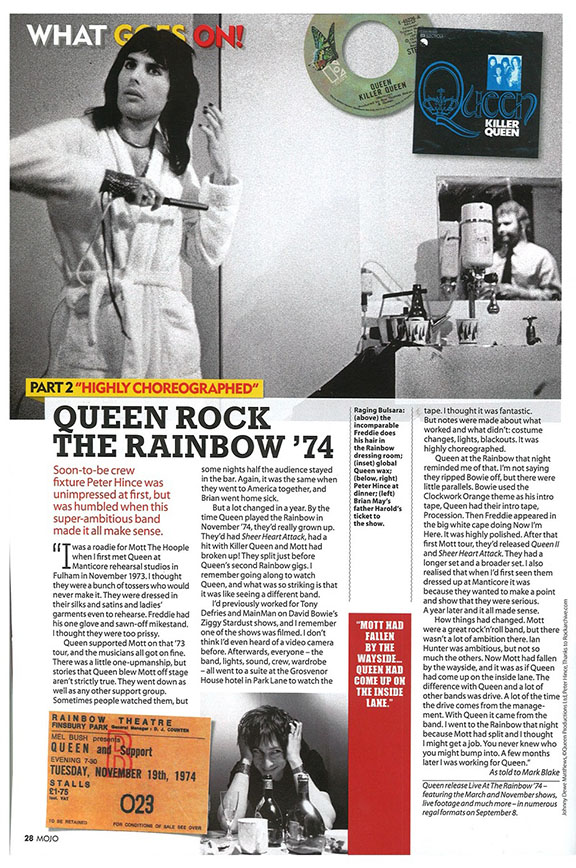A “Live At The Rainbow” feature for which Brian May and Roger Taylor both gave interviews in the new issue of MOJO out today 26 August 2014.
Also 4 * Album review and cover mention.

WHAT GOES ON!
QUEEN
ROCK THE
RAINBOW
IN 1974
The previous year they’d supported Mott The Hoople at the iconic Finsbury Park venue. Now they were returning as glamour crazed headliners on the verge of world domination. How did they get here?

The element of Mercury:
(main) Freddie and Brian
May (right) on-stage at
the Rainbow, March ’72;
(bottom row, from left)
roaring at the mirror;
John Deacon (left) and
May recline backstage;
Queen on tour with Mott
The Hoople (Roger Taylor,
bottom right); (insets) tour
poster, badges and vinyl.
“PEOPLE
STARTED
COMING TO
THE GIGS
DRESSED
UP AND
LOOKING
LIKE US”
Brian May
=====
PART 1 “EVERYTHING WAS DRAMATIC”

Queen’s Brian May (guitar) and Roger Taylor (drums) remember the spectacle, sickness and Sheer Heart Attack of their two 1974 Rainbow shows.
BRIAN MAY: “It’s incredible how much happened to Queen in 1974, and even in between the two Rainbow shows we played that year. We’d opened for Mott The Hoople in 73, and in spring 74, we were headlining. Our promoter Mel Bush said to us, ‘We’re going to finish this tour with a show at the Rainbow.’ And we said, ‘Mel, do you really think we could sell it out?’ We played the first Rainbow show in March. For the last three years it had felt as if it was just the four of us in Queen that believed in what we were doing. Then gradually there was a flood other people who believed as well. People started coming to the gigs dressed up and looking like us.
We had costumes made by Zandra Rhodes for the tour. Freddie [Mercury) and I wore ours, but Roger didn’t. I think he thought he was being made to wear a dress. What we were doing was unfashionable – a lot of progressive rock groups considered it fashionable to eschew any sense glamour, but we embraced those showbiz elements. And that’s what we tried to do at the Rainbow: overwhelm I audience’s senses. It’s like Freddie sang later [in Queen Let Me Entertain You), ‘And to thrill you, I’ll use any device.’
After that show, we went to America, opening for Mott again. But I became ill with hepatitis. The doctor said I had to go home. They had to smuggle me on the plane, I looked so bad. Back in England, after we’d started recording [third album) Sheer Heart Attack, I started throwing up and had to go to hospital for an operation [May had an ulcer). Freddie would bring in tapes of what the band were doing – all the harmonies on what became Killer Queen – telling me, ’Don’t worry, darling, we can’t do it without you.’
When we did the second Rainbow show [in November we’d had a hit with Killer Queen and the Sheer Heart Attack album. We opened the show with Now I’m Here, a song iId written in hospital partly about Mott The Hoople, who were like a symbol of rock’n’roll. When I see the footage of us from those shows now, I see so much confidence and adrenalin and I think, My God, we were such impatient boys.
Not long after, the two guy, in Sparks came to my house. They’d had a hit with This Town Ain’t Big Enough and they said to me, ‘Look, your band are OK, but you’re obviously not going to have any more hits, whereas we are going to conquer the world. Fancy joining us?’ I remember saying, I love you guys, but I don’t think so.
Queen were finally going somewhere.”
———-
PART 2 “HIGHLY CHOREOGRAPHED”
QUEEN ROCK THE RAINBOW ’74

Raging Bulsara:
(above) the
incomparable
Freddie does
his hair in
the Rainbow
dressing room;
(inset) global
Queen wax;
(below, right)
Peter Hince at
dinner; (left)
Brian May’s
father Harold’s
ticket to
the show.
“MOTT HAD
FALLEN
BY THE
WAYSIDE…
QUEEN HAD
COME IP ON
THE INSIDE
LANE.”
Soon-to-be crew fixture Peter Hince was unimpressed at first, but was humbled when this super-ambitious band made it all make sense.
I was a roadie for Mott The Hoople when I first met Queen at Manticore rehearsal studios in Fulham In November 1973. I thought they were a bunch of tossers, who would never make it. They were dressed in their silks and satins and ladies’ garments even to rehearse. Freddie had his one glove and sawn-off mike stand. I thought they were too prissy. Queen supported Mott on that ’73 tour, and the musicians all got on fine. There was a little one-upmanship, but stories that Queen blew Mott off stage aren’t strictly true/ They went down as well as any other support group.
Sometimes people watched them, but some nights half the audience stayed in the bar. Again, it was the same when they went to America together, and Brian went home sick. But a lot changed in a year. By the time Queen played the Rainbow in November ’74, they’d really grown up. They’d had Sheer Heart Attack, had a hit with Killer Queen and Mott had broken up. They split just before Queen’s second Rainbow gigs. I remember going along to watch Queen, and what was so striking Is that it was like seeing a different band.
I’d previously worked for Tony Defries and Main Man on David Bowie’s Ziggy Stardust shows, and I remember one of the shows was filmed. I don’t think I’d even heard of a video camera before. Afterwards, everyone – the band, lights. sound crew, wardrobe – all went to a suite at the Grosvenor House hotel In Park Lane to watch the tape. I thought it was fantastic. But notes were made about what worked and what didn’t: costume changes, lights, blackouts. It was highly choreographed.
Queen at the Rainbow that night reminded me of that. I’m not saying they ripped Bowie off, but there were little parallels. Bowie used the Clockwork Orange theme as his Intro tape, Queen had their intro tape, Procession. Then Freddie appeared in the big white cape doing Now I’m Here. It was highly polished. After that first Mott tour, they’d released Queen II and Sheer Heart Attack. They had a longer set and a broader set. I also realised that when I’d first seen them dressed up at Manticore it was because they wanted to make a point and show that they were serious. A year later and it all made sense.
How things had changed. Mott were a great rock’n’roll band, but there wasn’t a lot of ambition there. Ian Hunter was ambitious, but not so much the others. Now Mott had fallen by the wayside, and it was as if Queen had come up on the inside lane. The difference with Queen and a lot of other bands was drive. A lot or the time the drive comes from the management. With Queen it came from the band.
I went to the Rainbow that night because Mott had split and I thought I might get a job. You never know who you might bump into. A few months later I was working for Queen.
As told to Mark Blake
Queen release Live At The Rainbow ’74 – featuring the March and November shows, live footage and much more – in numerous regal formats on September 8.